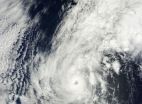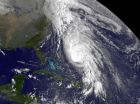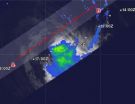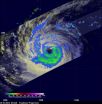Viral alliances overcoming plant defenses
Could lead to new generation of viruses
2012-10-17
(Press-News.org) PULLMAN, Wash.— Washington State University researchers have found that viruses will join forces to overcome a plant's defenses and cause more severe infections.
"These findings have important implications in our ability to control these viruses", says Hanu Pappu, Sam Smith Distinguished Professor of Plant Virology and chair of WSU's Department of Plant Pathology. "Mixed infections are quite common in the field and now we know that viruses in these mixed infections are helping each other at the genetic level to overcome host defenses and possibly lead to the generation of new viruses."
Pappu publishes his findings in the latest issue of the journal PLOS ONE. Joining him are PhD student Sudeep Bag and Neena Mitter, an associate professor at Australia's University of Queensland.
The researchers focused on Iris yellow spot virus and Tomato spotted wilt virus after Bag discovered that, when they infect the same plant, they helped each other overcome a plant's defense response. With Mitter's help and sophisticated molecular techniques, Bag found both viruses dramatically changed their genetic expression, breaking down the plant's defenses and leading to more severe disease. Bag also found that genes from the Tomato spotted wilt virus seemed to "aid and abet" Iris yellow spot virus as it spread throughout the plant and caused more disease.
Growers should take this phenomenon into account, says Pappu, with broader management tactics targeting more than one virus and possible variations.
INFORMATION:
The research was funded in part by the Specialty Crops Research Initiative of the National Institute of Food and Agriculture, a branch of the U.S. Department of Agriculture.
The paper, "Complementation between Two Tospoviruses Facilitates the Systemic Movement of a Plant Virus Silencing Suppressor in an Otherwise Restrictive Host," can be found at http://dx.plos.org/10.1371/journal.pone.0044803.
END
ELSE PRESS RELEASES FROM THIS DATE:
2012-10-17
Though not often considered beyond the plasma television, small-scale microplasmas have great utility in a wide variety of applications. Recently, new developments have begun to capitalize on how these microplasmas interact with liquids in applications ranging from killing bacteria for sterilizing a surface to rapidly synthesizing nanoparticles.
An interdisciplinary collaboration between researchers at Case Western Reserve University and the University of Notre Dame has revealed a critical interaction that is occurring at this plasma-liquid interface in that the electrons ...
2012-10-17
No matter which way you look at it, rejection hurts. Experiencing rejection from a boss, a friend, or a partner is difficult enough for many adults to handle. But adolescents, who are dealing with the one-two punch of biological and social change, may be the most vulnerable to its negative effects.
In a new study published in Clinical Psychological Science, a journal of the Association for Psychological Science, researcher Michael Murphy and colleagues examine the human immune response as a potential link between social stressors like rejection and later mental and physical ...
2012-10-17
Cambridge, Mass. - October 16, 2012 - Atmospheric chemists at the Harvard School of Engineering and Applied Sciences (SEAS) have found that when it comes to secondary organic material in the atmosphere, there are two distinct breeds: liquids and jellies.
Secondary organic materials (SOM) are airborne particles that have begun to react with gases in the atmosphere. In the last 20 years' research and climate modeling, these SOM particles have been assumed to drift as liquids. In a liquid phase, the organic materials would absorb other compounds like ammonia or ozone very ...
2012-10-17
The song "How do you solve a problem like Maria?" from the famous film "The Sound of Music" comes to mind when looking at NASA satellite imagery of Tropical Storm Maria churning in the western North Pacific Ocean. The answer lies in increased wind shear and cool ocean temperatures – two factors that can weaken the storm, but won't be present over the next day or two.
NASA's Aqua satellite passed over Tropical Storm Maria on Oct. 16 at 0355 UTC, 12:55 p.m. local time Tokyo/Japan (Oct. 15 at 11:55 p.m. EDT) and the Moderate Resolution Imaging Spectroradiometer (MODIS) instrument ...
2012-10-17
NASA's Aqua satellite captured a stunning image of Hurricane Paul in the eastern Pacific Ocean that revealed Mexico's Socorro Island was just outside of Paul's eye. Now, Paul is expected to track along the Baja California coast, triggering more warnings.
Hurricane Paul is stirring up rough seas in the eastern Pacific Ocean and warnings are posted along Baja California.
A hurricane warning is in effect for the west coast of Baja California from Santa Fe northward to Punta Abreojos. A tropical storm warning is in effect for the west coast of Baja California north of Punta ...
2012-10-17
Hurricane Rafael is a large hurricane and Bermuda has battened down for Rafael's battering today, Oct. 16. NOAA's GOES-14 satellite revealed Rafael's large span that covers several hundred miles and dwarfs Bermuda.
NOAA's GOES-14 satellite captured a visible image of Tropical Storm Rafael in the Atlantic on Oct. 16 at 7:45 a.m. EDT. The image shows the extent of Hurricane Rafael, which is over 410 miles in diameter. That's longer than the distance between Boston and Washington, D.C. The visible image also showed a thick row of clouds northwest of Rafael. Those clouds ...
2012-10-17
VIDEO:
Dr. O'Shea discusses her research.
Click here for more information.
LA JOLLA, CA---- Cold viruses generally get a bad rap----which they've certainly earned----but new findings by a team of scientists at the Salk Institute for Biological Studies suggest that these viruses might also be a valuable ally in the fight against cancer.
Adenovirus, a type of cold virus, has developed molecular tools----proteins----that allow it to hijack a cell's molecular machinery, including ...
2012-10-17
Satellite imagery from NASA's TRMM satellite showed that wind shear is pushing the bulk of rainfall away from the center of Tropical Storm Anais.
When NASA's Tropical Rainfall Measuring Mission (TRMM) satellite passed over Tropical Storm Anais on Oct. 16 at 0654 UTC (2:54 a.m. EDT), light to moderate rainfall was occurring southeast of the center and falling at a rate between .78 to 1.57 inches/20 to 40 mm per hour. The displacement of rainfall from around the storm's center to the southeast indicates moderate to strong northwesterly wind shear.There no areas of heavy ...
2012-10-17
Tropical Storm Prapiroon is still meandering in the western north Pacific Ocean, and NASA's TRMM satellite noticed that dry air and wind shear are adversely affecting rainfall north of the storm's center.
NASA's Tropical Rainfall Measuring Mission (TRMM) satellite flew above Prapiroon when it was a typhoon on Oct. 15, 2012 at 0632 UTC (2:32 a.m. EDT). Prapiroon's sustained wind speeds had dropped to 70 knots (~81 mph) with a large and ragged eye being its dominant feature. TRMM's Microwave Imager (TMI) data indicated that the most intense rain bands south of Prapiroon's ...
2012-10-17
NASA's Operation IceBridge got the 2012 Antarctic campaign off to a productive start with a land ice survey of Thwaites Glacier and a sea ice flight over parts of the Bellingshausen Sea.
During the first few weeks of a campaign, IceBridge typically concentrates on sea ice before it begins to melt as spring temperatures rise, but as often happens in the field, the weather had other ideas.
On Oct. 12, the IceBridge team met with meteorologists at the Punta Arenas airport to discuss weather conditions and make a final decision on where to fly. "The forecast for all sea ...
LAST 30 PRESS RELEASES:
[Press-News.org] Viral alliances overcoming plant defenses
Could lead to new generation of viruses







